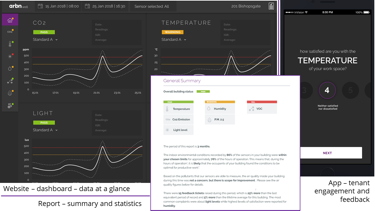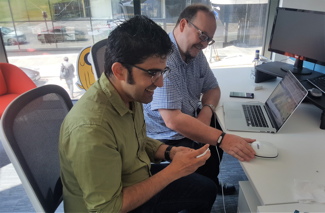Transformative technologies

Parag Rastogi explores why there is a new focus on providing healthy workplaces, and how technology is helping to achieve them.
We spend 80-90% of our time indoors*, and a huge chunk of that is in the workplace. So why hasn’t health and wellbeing in the workplace been taken more seriously over the last 20 years? In 2018 though, it is firmly on the agenda, as employers look to compete on offering the best working environment.
There are several reasons why health and wellbeing in the workplace are now significant considerations for employers. There is a better standard of living now than 100 years ago, and this is helping drive improvements as we look to lead healthier lives. There are also newer insights into how the body works. The recent discovery that the eye entrains the body clock (circadian rhythm) to the sun to regulate the production of a hormone called melatonin is just one example of this. Everyone knew that sunshine and fresh air was good for people, but didn’t necessarily know how and why.
Property technology company Arbnco has launched a service that provides real-time monitoring of the aspects of the indoor working environment that have an impact on health and wellbeing. The service (ArbnWell) was devised as a result of a research project in partnership with the University of Strathclyde and funded by Construction Scotland Innovation Centre. The project collected data from commercial properties in New York, London, and Glasgow working with TH Real Estate.
Even with a well-designed building, design intent has little influence on how a building actually performs, especially in terms of employee wellbeing. Real-time monitoring to inform and improve building operation is where the real gains are to be made.
ArbnWell involves ubiquitous monitoring of indoor environmental conditions combined with engagement with occupants to gather data on how a building is actually performing. Factors such as ventilation, natural light, and temperature are taken into account. Large amounts of data are collected and collated in a way that matches client requirements.
Sensor technology
Developments in technology have had a huge impact on the monitoring of indoor environmental conditions, and we can monitor more than ever before. However, the real advance is in affordability. Twenty years ago, sensors in the workplace would have been prohibitively expensive. They have since become cheaper to manufacture and now use less power, making the technology accessible to the wider market.
 |
| Tracking data: influences on wellbeing can be monitored and tracked with the latest technology |
What to measure?
The human body can detect a number of external factors, and produces warning signs such as sweating in an overly stuffy or warm office. The nose can also detect a lot of issues, but it can only sense something when it becomes acute, so you know when something smells odd or you find yourself sneezing in a dusty environment.
However, over time humans can acclimatise to smells, dust and pollution until it becomes unnoticeable. Sensor technology can detect air quality far more accurately and consistently than the human nose. Ideally, the following factors will be carefully monitored:
VOC – Volatile Organic Compounds are organic chemicals that are potentially dangerous to human health or damaging to the environment. Most scents or smells we experience day-to-day are VOCs, like the ‘new-car smell’.
PM 1/2.5/10 – Particulate Matter refers to fine particles of approximately 1, 2.5, and 10 micrometres in diameter. These particles can get into the lungs and trigger or worsen serious health problems such as asthma, heart attacks, bronchitis and other respiratory problems.
CO2 – While not a toxin in the concentrations normally seen in buildings, concentrations of CO2 that are substantially higher than fresh air reduce the ability to focus or stay awake.
Humidity – Invisible to the human eye, this is the measurement of water vapour in the atmosphere. Humans can usually only detect large changes in humidity, but consistently elevated humidity levels lead to dampness in properties and may cause mould growth. Consistently low levels of humidity cause uncomfortable dryness and build-up of static charge.
Temperature – Often the cause of many an office argument, temperature may be easily detectable by humans, but individuals can feel vastly different from one another at the same temperature. Arbnco’s sensors can also produce heat maps of working spaces to understand where the hot spots are, which can help building and facilities managers to design better working environments and plan desk layouts.
Light – Lighting is one of the most important features of an office environment, and improving the availability of daylight in the workspace may improve occupants’ mood and satisfaction.
 |
| At work with the latest sensors to track wellbeing factors |
It’s important to point out that not all the measured parameters have the same meaning. For example, temperature or humidity going out of specification isn’t catastrophic, but CO2, VOC or PM going out of specification is something to be closely investigated. The effect of CO2, for example, is so mild that people don’t notice it until they start falling asleep.
However, measuring temperature or CO2 is not the entire solution. It is putting the data in context and processing it into an understandable and accessible format that makes the real difference. Measuring data at a high resolution and tempo gives an organisation the complete long-term picture of its building. There are professional bodies such as CIBSE or ASHRAE that have established standards in terms of the recommended levels, which help to understand what is in and out of specification.
Occupant engagement
The definition of wellbeing within the workplace is quite nebulous, but the general consensus is that it is freedom from disease at the baseline, as well as the physical and mental conditions that allow you to be happy, satisfied and productive.
Therefore, it is imperative that occupants are engaged when monitoring wellbeing and productivity in the workplace. Occupants need to feel happy, satisfied and productive and a key element of the engagement is to demonstrate that they are being listened to and feedback is taken on board.
One way of doing so is to offer a feedback mechanism, enabling them to contact building and facilities managers. Looking forward, the occupants’ feedback can be analysed to build in predictions about when people are likely to complain.
This mixture of quantitative and qualitative analyses will help organisations deploy improvements across a property portfolio and bring a new level of detail in measurement and analytics to buildings that have previously been managed without proper feedback and assessment. In addition, the control of buildings to improve the quality of the indoor air for health and comfort has a direct impact on energy use.
The monitoring of workplace health and wellbeing is something we should have been doing for years. Not only is a comfortable office environment good for the wellbeing of staff, it has been demonstrated in numerous studies to have an intuitive link o alertness and performance.
ArbnWell aims to create standard specifications for what commercial properties should be like in terms of health, happiness and the wellbeing of staff.
Parag Rastogi is lead building physicist at Arbnco and a postdoctoral research fellow at the University of Strathclyde
* www.buildinggreen.com/blog/we-spend-90-our-time-indoors-says-who








